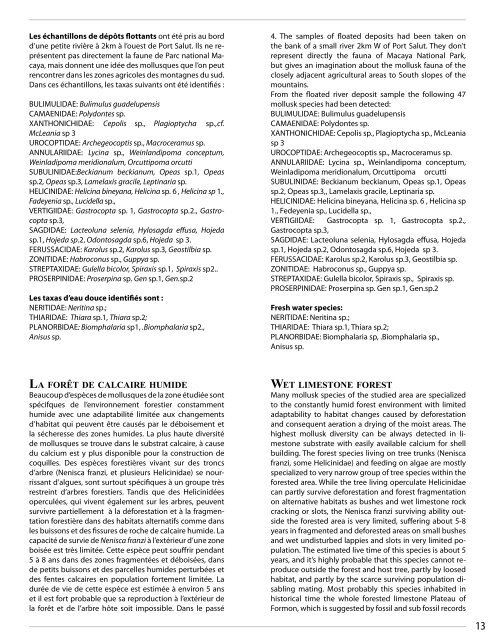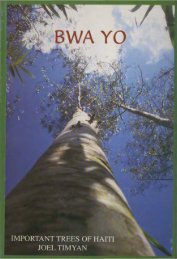Biodiversité - Société Audubon Haiti
Biodiversité - Société Audubon Haiti
Biodiversité - Société Audubon Haiti
Create successful ePaper yourself
Turn your PDF publications into a flip-book with our unique Google optimized e-Paper software.
Les échantillons de dépôts flottants ont été pris au bord<br />
d’une petite rivière à 2km à l’ouest de Port Salut. Ils ne représentent<br />
pas directement la faune de Parc national Macaya,<br />
mais donnent une idée des mollusques que l’on peut<br />
rencontrer dans les zones agricoles des montagnes du sud.<br />
Dans ces échantillons, les taxas suivants ont été identifiés :<br />
BULIMULIDAE: Bulimulus guadelupensis<br />
CAMAENIDAE: Polydontes sp.<br />
XANTHONICHIDAE: Cepolis sp., Plagioptycha sp.,cf.<br />
McLeania sp 3<br />
UROCOPTIDAE: Archegeocoptis sp., Macroceramus sp.<br />
ANNULARIIDAE: Lycina sp., Weinlandipoma conceptum,<br />
Weinladipoma meridionalum, Orcuttipoma orcutti<br />
SUBULINIDAE:Beckianum beckianum, Opeas sp.1, Opeas<br />
sp.2, Opeas sp.3, Lamelaxis gracile, Leptinaria sp.<br />
HELICINIDAE: Helicina bineyana, Helicina sp. 6 , Helicina sp 1.,<br />
Fadeyenia sp., Lucidella sp.,<br />
VERTIGIIDAE: Gastrocopta sp. 1, Gastrocopta sp.2., Gastrocopta<br />
sp.3,<br />
SAGDIDAE: Lacteoluna selenia, Hylosagda effusa, Hojeda<br />
sp.1, Hojeda sp.2, Odontosagda sp.6, Hojeda sp 3.<br />
FERUSSACIDAE: Karolus sp.2, Karolus sp.3, Geostilbia sp.<br />
ZONITIDAE: Habroconus sp., Guppya sp.<br />
STREPTAXIDAE: Gulella bicolor, Spiraxis sp.1, Spiraxis sp2..<br />
PROSERPINIDAE: Proserpina sp. Gen sp.1, Gen.sp.2<br />
Les taxas d’eau douce identifiés sont :<br />
NERITIDAE: Neritina sp.;<br />
THIARIDAE: Thiara sp.1, Thiara sp.2;<br />
PLANORBIDAE: Biomphalaria sp1, .Biomphalaria sp2.,<br />
Anisus sp.<br />
la forêt de calcaIre huMIde<br />
Beaucoup d’espèces de mollusques de la zone étudiée sont<br />
spécifques de l’environnement forestier constamment<br />
humide avec une adaptabilité limitée aux changements<br />
d’habitat qui peuvent être causés par le déboisement et<br />
la sécheresse des zones humides. La plus haute diversité<br />
de mollusques se trouve dans le substrat calcaire, à cause<br />
du calcium est y plus disponible pour la construction de<br />
coquilles. Des espèces forestières vivant sur des troncs<br />
d’arbre (Nenisca franzi, et plusieurs Helicinidae) se nourrissant<br />
d’algues, sont surtout spécifiques à un groupe très<br />
restreint d’arbres forestiers. Tandis que des Helicinidées<br />
operculées, qui vivent également sur les arbres, peuvent<br />
survivre partiellement à la déforestation et à la fragmentation<br />
forestière dans des habitats alternatifs comme dans<br />
les buissons et des fissures de roche de calcaire humide. La<br />
capacité de survie de Nenisca franzi à l’extérieur d’une zone<br />
boisée est très limitée. Cette espèce peut souffrir pendant<br />
5 à 8 ans dans des zones fragmentées et déboisées, dans<br />
de petits buissons et des parcelles humides perturbées et<br />
des fentes calcaires en population fortement limitée. La<br />
durée de vie de cette espèce est estimée à environ 5 ans<br />
et il est fort probable que sa reproduction à l’extérieur de<br />
la forêt et de l’arbre hôte soit impossible. Dans le passé<br />
4. The samples of floated deposits had been taken on<br />
the bank of a small river 2km W of Port Salut. They don’t<br />
represent directly the fauna of Macaya National Park,<br />
but gives an imagination about the mollusk fauna of the<br />
closely adjacent agricultural areas to South slopes of the<br />
mountains.<br />
From the floated river deposit sample the following 47<br />
mollusk species had been detected:<br />
BULIMULIDAE: Bulimulus guadelupensis<br />
CAMAENIDAE: Polydontes sp.<br />
XANTHONICHIDAE: Cepolis sp., Plagioptycha sp., McLeania<br />
sp 3<br />
UROCOPTIDAE: Archegeocoptis sp., Macroceramus sp.<br />
ANNULARIIDAE: Lycina sp., Weinlandipoma conceptum,<br />
Weinladipoma meridionalum, Orcuttipoma orcutti<br />
SUBULINIDAE: Beckianum beckianum, Opeas sp.1, Opeas<br />
sp.2, Opeas sp.3,, Lamelaxis gracile, Leptinaria sp.<br />
HELICINIDAE: Helicina bineyana, Helicina sp. 6 , Helicina sp<br />
1., Fedeyenia sp., Lucidella sp.,<br />
VERTIGIIDAE: Gastrocopta sp. 1, Gastrocopta sp.2.,<br />
Gastrocopta sp.3,<br />
SAGDIDAE: Lacteoluna selenia, Hylosagda effusa, Hojeda<br />
sp.1, Hojeda sp.2, Odontosagda sp.6, Hojeda sp 3.<br />
FERUSSACIDAE: Karolus sp.2, Karolus sp.3, Geostilbia sp.<br />
ZONITIDAE: Habroconus sp., Guppya sp.<br />
STREPTAXIDAE: Gulella bicolor, Spiraxis sp., Spiraxis sp.<br />
PROSERPINIDAE: Proserpina sp. Gen sp.1, Gen.sp.2<br />
Fresh water species:<br />
NERITIDAE: Neritina sp.;<br />
THIARIDAE: Thiara sp.1, Thiara sp.2;<br />
PLANORBIDAE: Biomphalaria sp, .Biomphalaria sp.,<br />
Anisus sp.<br />
Wet lIMestone forest<br />
Many mollusk species of the studied area are specialized<br />
to the constantly humid forest environment with limited<br />
adaptability to habitat changes caused by deforestation<br />
and consequent aeration a drying of the moist areas. The<br />
highest mollusk diversity can be always detected in limestone<br />
substrate with easily available calcium for shell<br />
building. The forest species living on tree trunks (Nenisca<br />
franzi, some Helicinidae) and feeding on algae are mostly<br />
specialized to very narrow group of tree species within the<br />
forested area. While the tree living operculate Helicinidae<br />
can partly survive deforestation and forest fragmentation<br />
on alternative habitats as bushes and wet limestone rock<br />
cracking or slots, the Nenisca franzi surviving ability outside<br />
the forested area is very limited, suffering about 5-8<br />
years in fragmented and deforested areas on small bushes<br />
and wet undisturbed lappies and slots in very limited population.<br />
The estimated live time of this species is about 5<br />
years, and it’s highly probable that this species cannot reproduce<br />
outside the forest and host tree, partly by loosed<br />
habitat, and partly by the scarce surviving population disabling<br />
mating. Most probably this species inhabited in<br />
historical time the whole forested limestone Plateau of<br />
Formon, which is suggested by fossil and sub fossil records<br />
13



